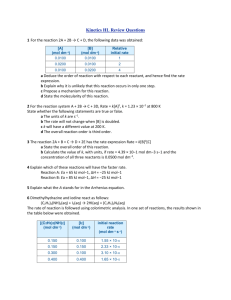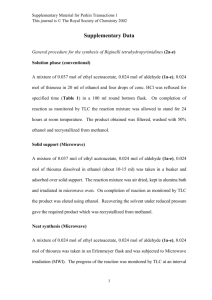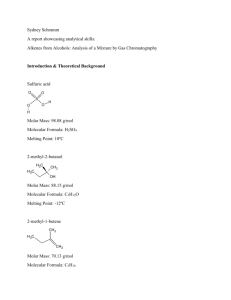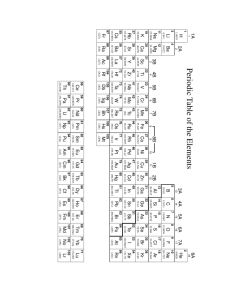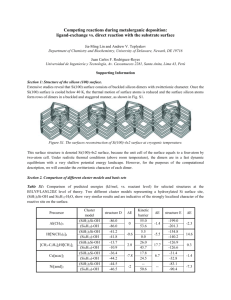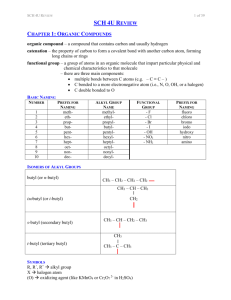Chemistry
advertisement
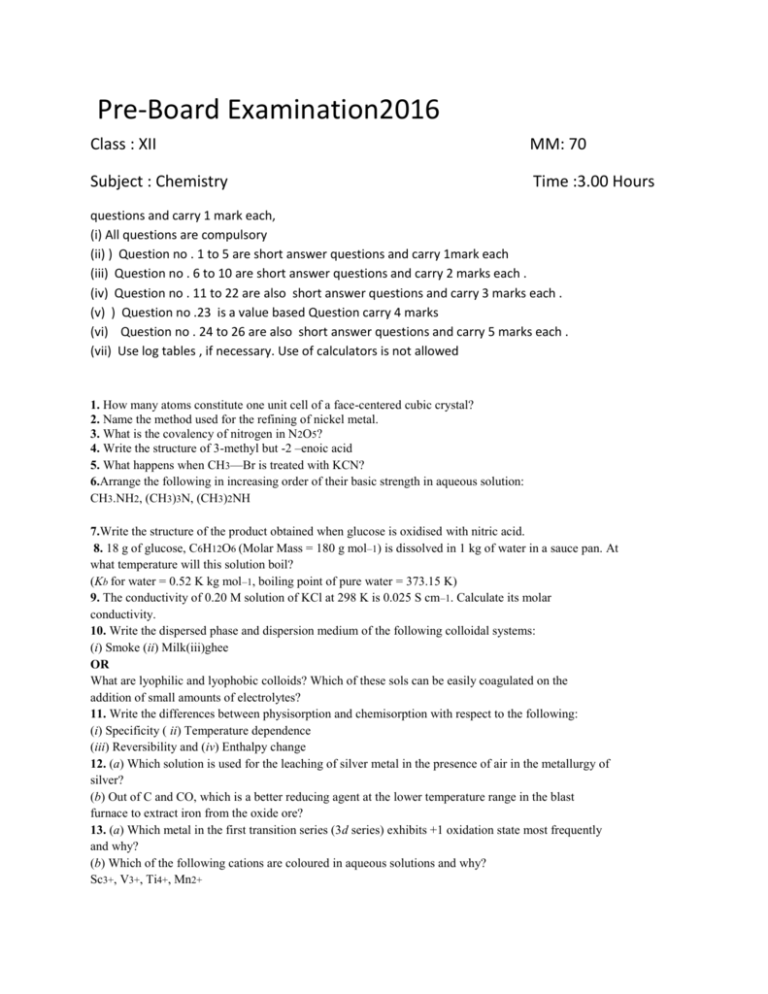
Pre-Board Examination2016 Class : XII MM: 70 Subject : Chemistry Time :3.00 Hours questions and carry 1 mark each, (i) All questions are compulsory (ii) ) Question no . 1 to 5 are short answer questions and carry 1mark each (iii) Question no . 6 to 10 are short answer questions and carry 2 marks each . (iv) Question no . 11 to 22 are also short answer questions and carry 3 marks each . (v) ) Question no .23 is a value based Question carry 4 marks (vi) Question no . 24 to 26 are also short answer questions and carry 5 marks each . (vii) Use log tables , if necessary. Use of calculators is not allowed 1. How many atoms constitute one unit cell of a face-centered cubic crystal? 2. Name the method used for the refining of nickel metal. 3. What is the covalency of nitrogen in N2O5? 4. Write the structure of 3-methyl but -2 –enoic acid 5. What happens when CH3—Br is treated with KCN? 6.Arrange the following in increasing order of their basic strength in aqueous solution: CH3.NH2, (CH3)3N, (CH3)2NH 7.Write the structure of the product obtained when glucose is oxidised with nitric acid. 8. 18 g of glucose, C6H12O6 (Molar Mass = 180 g mol–1) is dissolved in 1 kg of water in a sauce pan. At what temperature will this solution boil? (Kb for water = 0.52 K kg mol–1, boiling point of pure water = 373.15 K) 9. The conductivity of 0.20 M solution of KCl at 298 K is 0.025 S cm–1. Calculate its molar conductivity. 10. Write the dispersed phase and dispersion medium of the following colloidal systems: (i) Smoke (ii) Milk(iii)ghee OR What are lyophilic and lyophobic colloids? Which of these sols can be easily coagulated on the addition of small amounts of electrolytes? 11. Write the differences between physisorption and chemisorption with respect to the following: (i) Specificity ( ii) Temperature dependence (iii) Reversibility and (iv) Enthalpy change 12. (a) Which solution is used for the leaching of silver metal in the presence of air in the metallurgy of silver? (b) Out of C and CO, which is a better reducing agent at the lower temperature range in the blast furnace to extract iron from the oxide ore? 13. (a) Which metal in the first transition series (3d series) exhibits +1 oxidation state most frequently and why? (b) Which of the following cations are coloured in aqueous solutions and why? Sc3+, V3+, Ti4+, Mn2+ (At. nos. Sc = 21, V = 23, Ti = 22, Mn = 25) 14. Chlorobenzene is extremely less reactive towards a nucleophilic substitution reaction. Give two reasons for the same. 15. How will you convert:(i) Propene to Propan–2–ol?(ii) Phenol to 2, 4, 6 – trinitrophenol? 16. (a) What type of semiconductor is obtained when silicon is doped with boron? (b) What type of magnetism is shown in the following alignment of magnetic moments? (c) What type of point defect is produced when AgCl is doped with CdCl 2? 17. Determine the osmotic pressure of a solution prepared by dissolving 2.5 × 10 –2 g of K2SO4 in 2 L of water at 25oC, assuming that it is completely dissociated. (R = 0.082 L atm K–1 mol–1, Molar mass of K2SO4 = 174 g mol–1). 18. Calculate the emf of the following cell at 298 K: Fe (s) | Fe2+ (0.001 M) || H+ (1M) | H2 (g) (1 bar), Pt (s) (Given E0 cell = + 0.44 V) 19. How would you account for the following? (i) Transition metals exhibit variable oxidation states. (ii) Zr (Z = 40) and Hf (Z = 72) have almost identical radii. (iii) Transition metals and their compounds act as catalyst. 20. Write the IUPAC names of the following coordination compounds: (i) [Cr(NH3)3Cl3] (ii) K3[Fe (CN)6] (iii) [CoBr2(en)2]+, (en = ethylenediamine) 21. Write the names and structures of the monomers of the following polymers: (i) Buna–S (ii) Neoprene (iii) Nylon–6, 6 22. After watching a programme on TV about the adverse effects of junk food and soft drinks on the health of school children, Sonali, a student of Class XII, discussed the issue with the school principal. Principal immediately instructed the canteen contractor to replace the fast food with the fibre and vitamins rich food like sprouts, salad, fruits, etc. This decision was welcomed by the parents and the students. After reading the above passage, answer the following questions: (a) What values are expressed by Sonali and the Principal of the school? (b) Give two examples of water-soluble vitamin 23 (a) Which one of the following is a food preservative? Equanil, Morphine, Sodium benzoate (b) Why is bithional added to soap? (c) Which class of drugs is used in sleeping pil 24. (a) Why does rate of reaction become double for every 10 0 rise in temperature ? (b) At 3800 c the half life period for the first order decomposition of H2 O2 is 360 min.The activation energy of the reaction is 200 kj mole-1. Calculate the time required for 75% decomposition at 450 0c . (c) In – dx/dt, What is the meaning of negative sign. OR (a) For a first order reaction, show that time required for 99% completion is twice the time required for the completion of 90% of reaction. (b) Rate constant ‘k’ of a reaction varies with temperature ‘T’ according to the equation: log k = log A –Ea /2 .303 R T ( 1/T) Where Ea is the activation energy. When a graph is plotted for log k vs.1 /T, a straight line with a slope of – 4250 K is obtained. Calculate ‘Ea’ for the reaction. (R = 8.314 JK–1 mol–1) 25. (a) Give reasons for the following: (i) Bond enthalpy of F2 is lower than that of Cl2. (ii) PH3 has lower boiling point than NH3. (b) Draw the structures of the following molecules: (i) BrF3 (ii) (HPO3)3 (iii) XeF4 OR (a) Complete the following reactions: (i) 2H—CHO. KOH conc (ii) CH3COOH Br2/P (iii)(b) Give simple chemical tests to distinguish between the following pairs of compounds: (i) Ethanal and Propanal (ii) Benzoic acid and Phenol 26. (a) Although phenoxide ion has more number of resonating structures than carboxylate ion, carboxylic acid is a stronger acid than phenol. Give two reasons. (b) How will you bring about the following conversions? (i) Propanone to propane (ii) Benzoyl chloride to benzaldehyde (iii) Ethanal to but-2-enal OR (a) Account for the following: (i) Helium is used in diving apparatus. (ii) Fluorine does not exhibit positive oxidation state. (iii) Oxygen shows catenation behaviour less than sulphur. (b) Draw the structures of the following molecules: (i) XeF2 (ii) H2 S2 O8 SOLUTION 1. (8 corner atoms) 1/8 (6 face centre atoms)1 /2= 1 + 3 = 4 2. Mond Process. 3. 4 4. 4-Chloropent-1-ene. 5. CH3Br KCN CH3C N Ethanenitrile 6. CH CHCHCH CHO 4 3 32 2 1 3 7. (CH3 ) 3 N CH3NH2 (CH3 ) 2 NH 7. (CH3 ) 3 N CH3NH2 (CH3 ) 2 NH 8. There are three types of RNAs: (i) Ribosomal RNA (rRNA) (ii) Messenger RNA (mRNA) (iii) Transfer RNA (tRNA) 9. Moles of glucose 18 g / 180 g mol1 = 0.1 mol Mass of solvent = 1 kg Hence, molality of glucose solution = 0.1 mol kg–1 For water, change in boiling point will be Tb Kb m = 0.52 K kg mol–1 × 0.1 mol kg–1 = 0.052 K. Since water boils at 373.15 K at 1.013 bar pressure, the boiling point of solution will be 373.15 + 0.052 = 373.202 K. 10. m k c 0.025 S cm 1000 cm L 0.20 m 1 3 –1 1000 ol L 125 1 S cm 2 mol 1 11. Type of Colloid Dispersed Phase Dispersion Medium (i) Smoke Solid Gas (ii) Milk Liquid Liquid OR Lyophilic sols are solvents attracting sols whereas lyophobic sols are solvent repelling sols. Lyophobic sols can be easily coagulated. 12. Physisorption Chemisorption (i) Specificity It is not specific in nature. It is highly specific in nature. (ii) Temperature dependence Low temperature is favourable for adsorption. It decreases with increase of temperature. High temperature is favourable for adsorption. It increases with the increase of temperature. (iii) Reversibility It is reversible in nature. It is irreversible. (iv) Enthalpy change Enthalpy of adsorption is low (20–40 kJ mol1) in this case. Enthalpy of adsorption is high (80-240 kJ mol1) in this case. 13. (a) Dilute solution of NaCN. (b) CO. 14. (i) When PCl5 is heated, the less stable axial bonds break to form PCl3 .PCl5 PCl + Cl Heat 32. (ii) Orthophosphorous acid on heating disproportionates to give orthophosphoric acid and








